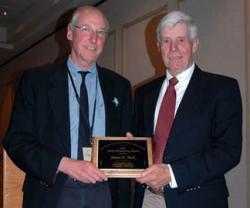

The Smith-Wintemberg Award is presented to honour members of the Canadian archaeological community who have made outstanding contributions to the advancement of the discipline of archaeology and to our knowledge of Canada's archaeological past. This, our Association's highest award, is presented in any year, as merited, to recognize outstanding achievement or service. This year the Smith-Wintemberg award, as unanimously approved by the executive, is awarded to Dr. James Tuck.
What we know of the fascinating archaeology and early history of Newfoundland and Labrador is due more to the efforts of James Tuck than to any other single individual. Indeed, so significant is his work that it has fundamentally reshaped our understanding of early European settlement in eastern Canada – a period that, before Jim came along, seemed lost in the mists of time and dominated by the exploits of famous explorers.
Jim began his academic career at Syracuse University in New York where he received both his undergraduate degree and, in 1968, his PhD in Anthropology. His research on the Onondaga Iroquois set the bar for his future work, and the photograph of the immaculately excavated long-house at Howlett Hill, has become a mainstay of undergraduate archaeology textbooks in Canada and abroad.
In 1967 he joined the Department of Anthropology at Memorial University in Newfoundland and began to transform our perception of Newfoundland and Labrador from that of a cultural backwater to one that has been centre stage, for several thousand years, to an extraordinary pageant of cultural interaction and development. His early work focused on prehistoric cultural issues, elucidating the history of the Maritime Archaic Indians at preeminent sites such as Port au Choix, as well as the history of the early Palaeo-Eskimo culture in Saglek Bay. When Bob McGhee joined the faculty at Memorial University in 1972 they set out together to explore the southern shores of Labrador and define the Maritime Archaic tradition in that area. In the process, they brought the earliest burial mound in the Americas to the attention of the world, signaling a sensibility in both men that viewed the public as a vital constituency in the pursuit of archaeology. About this time, Jim wrote two popular books on the prehistory of Newfoundland, Labrador, and Maritime Canada – popular not just with the public but with fellow archaeologists across Canada.
Jim subsequently went on to make enormous contributions to historical archaeology. Through convergence of meticulous archaeology, archival research, and scholarly collaboration, Jim's groundbreaking work at Red Bay brought to light a vigorous 16th century Basque whaling industry on southern Labrador. Again, public education and appreciation was just as important an outcome of this work as were the many academic publications that resulted.
With a Parks Canada interpretive centre established at Red Bay, Jim moved his research to the other end of the province, closer to St. John's where he began to uncover a 17th century settlement at Ferryland and document the Colony of Avalon. The archaeology at Ferryland has been spectacular beyond anyone's expectations. Anytime Jim has presented on this work at CAA meetings, the room is always packed, and we were left in awe of Jim's ability to marry archaeology and archival research to bring such an important story to life. But Jim's involvement with Ferryland went far beyond the norms of academic involvement. Jim was instrumental in establishing the journal Avalon Chronicles as a means of communication among researchers of early colonial history and archaeology in eastern North America. But most impressive have been Jim's tireless efforts to develop and interpret the site for the benefit of the public and the local community. There is a thriving museum in Ferryland which Jim set up and furnished and his work at the site is ongoing.
Jim Tuck's outstanding contributions to Newfoundland and Canadian archaeology and history have been recognized through fellowship in the Royal Society of Canada, the Manning Award for Excellence in the Public Preservation of Historic Places, the Newfoundland Historical Society’s Heritage Award, the Henrietta Harvey Chair at Memorial University, and he has been awarded the Order of Newfoundland and Labrador. Jim, it is with great pleasure that the CAA adds the Smith-Wintemberg Award to this list of honours. Please join me in saluting the extraordinary career of Jim Tuck.
Jack Brink
Thunder Bay
May 16, 2009
